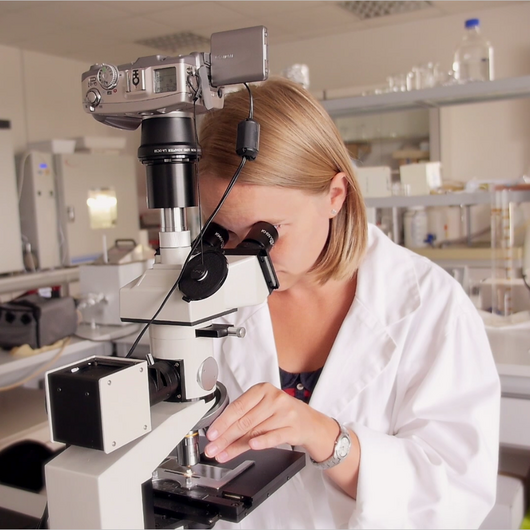Research and measurements
Research and measurements
The described measurements examined water from a Flaska bottle from different perspectives and compared it to identical water which was not in a Flaska bottle. The measurements revealed different changes in the water: we have found a common denominator in the term “vibrationally structured water”.
1. Tunjice Healing Resort; Report on the processing of water from a Flaska bottle using a GDV camera
Course:
3 water samples, 100 measurements for each, carried out on 28 June 2011.
Measurement results:
| Surface area | Average intensity | Entropy | Index RMS | |
|---|---|---|---|---|
| Tap water | 9518 | 5686 | 1.195e+004 | 1.135e+004 |
| FLASKA 5min | 1.395e+004 | 1.441e+004 | 1.832e+004 | 1.781e+004 |
| FLASKA 1 h | 2.169e+004 | 2.505e+004 | 1.488e+004 | 1.599e+004 |
| Criterion | 100.8 | 250 | 27.01 | 29.53 |
| p-value | 0.002544 | 0.006261 | 0.0007018 | 0.0007639 |
Conclusion:
The study showed that the Flaska bottle causes changes in water. A greater effect was noticeable in water which had been in a Flaska bottle for 1 hour. This water showed greater variation in surface area and intensity. Water which had only been in a Flaska bottle for 5 minutes showed an increased entropy and RMS index. The table displays the differences in values.
2. Bion, Institute for Bioelectromagnetics and New Biology; Report on the testing of the effects of water from a Flaska bottle on the human biofield
Course:
Samples from 10 persons, 6 measurements for each, carried out on 10 January 2013.
Measurement results:
Water from a Flaska bottle presumably has beneficial properties which affect the activation, entropy and overall energy of human organisms at the biofield level.
Measurement example:
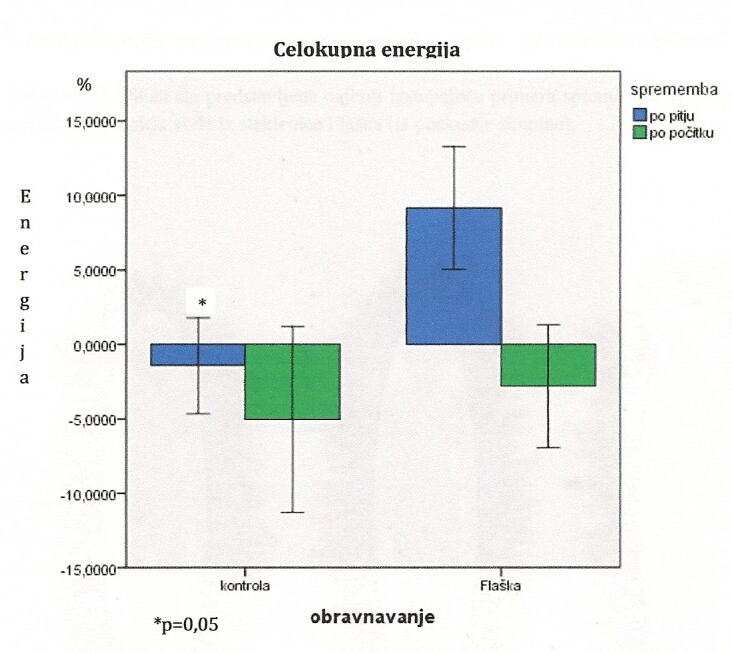
3. Peter Firbas, Private Laboratory of Plant Cytogenetics; Flaska bottle testing
Course:
4 measurements, 5 onions used for each, 200 metaphase cells examined, carried out on 28 June 2011.
Measurement results:
The level of genotoxicity decreases in the Flaska bottle from 20,0 percent to 11,0 percent. The results were obtained using Allium cepa L. onions. Allium metaphase genotoxicity test for drinking water, environmental samples and chemicals.
| Sam. | Methaphase Index |
Number of Methaphase Cells |
Number of Cells with Chromosome Anomalies |
Level of Genotoxicity (%) |
Average root lenght (mm) |
|---|---|---|---|---|---|
| I | 72 | 200 | 40 | 20.0* | 32 |
| II | 72 | 200 | 22 | 11.0* | 35 |
| III | 72 | 200 | 5 | 2.5 | 40 |
| IV | 72 | 100 | 21 | 21.0 | 22 |
4. European Institute for Water Diagnostics – EIWD; Evapo Image Testing
Course:
6 bottles in the test group and 6 bottles in the control group, carried out on 2 August 2012.
Measurement results:
The Flaska bottle showed a minor improvement in water droplet development structure, which is considered as a sign of higher water quality. Additional measurements with a larger number of samples are recommended.
Measurement example:
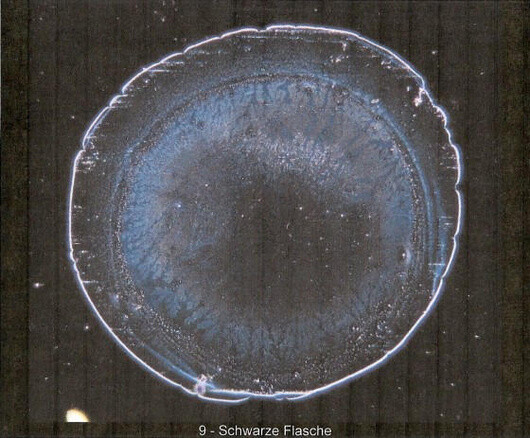
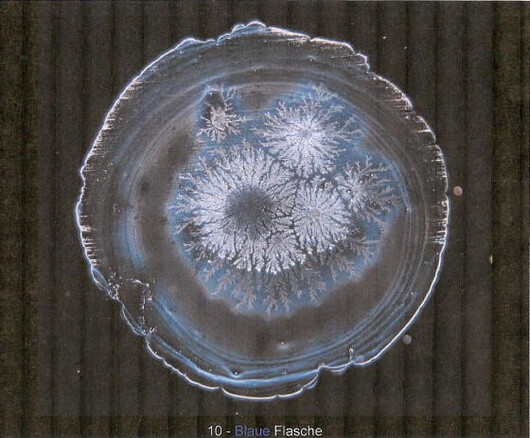
5. Office Masaru Emoto Tokyo, Japan; Flaska water crystal experiment
Course:
Freezing temperature -25°C, freezing time 4 hours, examination temperature -3°C, Olympus Optical Microscope (x200), 50 water samples from a Flaska bottle examined and 50 control samples examined, carried out on 14 December 2012.
Measurement results:
Tokyo tap water crystal photograph
Tokio tap water crystal after 5 minutes in Flaska
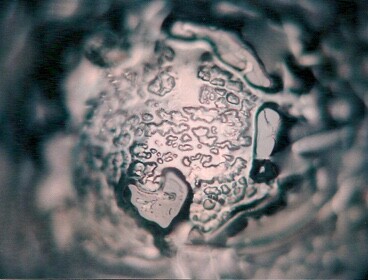
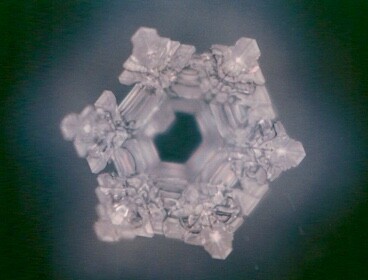
Tokio tap water crystal after 5 minutes in Flaska
6. Bion, Institute for electromagnetics and New Biology, Evapo testing
Course:
15 samples, 100 photos per sample, testing date: 28 August 2013
Conclusion:
The remains of the drops of the tested C mineral water have a well pronounced edge, a circle of a varying thickness, as well as a variety of mineral structures. Their true complexity is only visible with a high-resolution microscope inspection with a 100x to 400x magnification, which is inevitable for a plausible sphericity index assessment. The sphericity index of the Flaska samples is typically higher (by 55%) than the one of the non-incubated water (p = 0.03). Also the sphericity index of the Flaska typically differs (by 44%) from the sphericity of the samples from the control Flaska (p = 0.008).
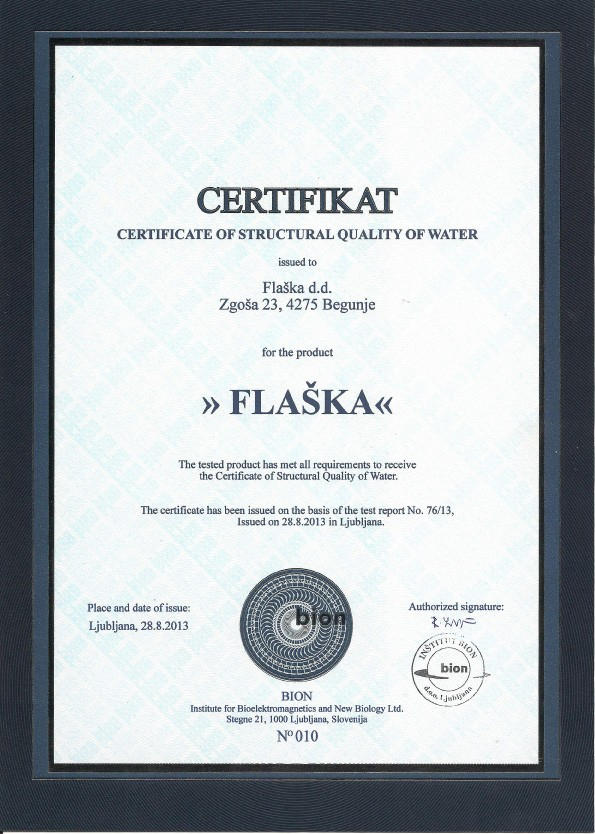
7. Laboratory of Microbiology Berthet, France, MicrotoxO test
Course:
Six batches, each batch of culture is tested in three copies (triplicate) whose average is included in the results. Report date:
Date:
May 2019
Conclusion:
The water contained in the Flaska bottle has a net inhibiting power on the growth of a the strain of "pathogenic" microbiotic bacteria; Escherichia Coli, as well as that of a strain of microbiotic bacteria described as "opportunistic pathogens"; Enterococcus faecalis. On the strain of Lactobacillus plantarum (biogenic bacteria i.e. useful), the water from the bottle Flaska has a neutral impact on this type of bacteria. According to these findings, it appears that a drinking water modified by the bottle Flaska is favorable for consumption because it contributes to the balance of the intestinal microbiota by not affecting the useful flora, called biogenic.
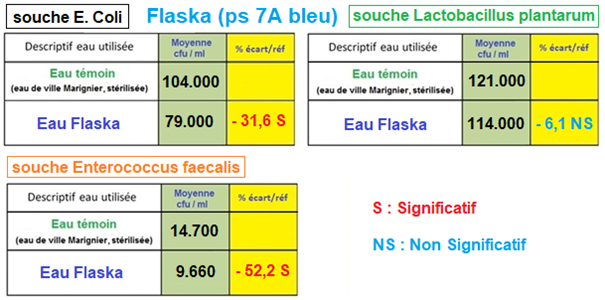
Measurement and testing summary
The described measurements examined water from a Flaska bottle from different perspectives and compared it to identical water which was not in a Flaska bottle. The measurements revealed different changes in the water: we have found a common denominator in the term “vibrationally structured water”. We would like to stress that this evidence is not recognized or dealt with by official science and accepted standards and is, for the time being, the subject of so-called alternative sciences.

